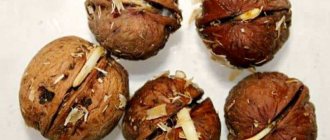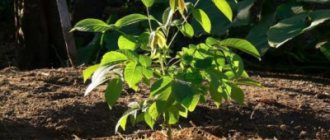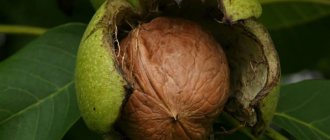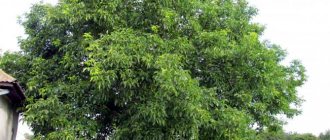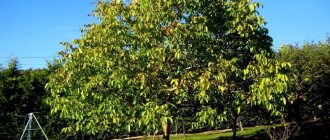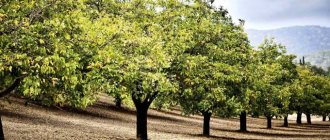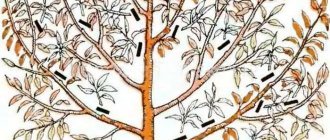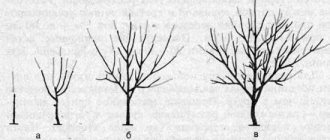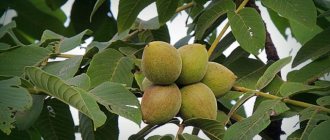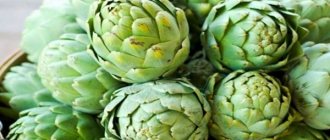Home/Garden and vegetable garden/Planting walnuts - how to properly plant walnuts in central Russia?
The most popular type of hazel is the walnut. The plant does not require complex or special care, but to get a good harvest you still need to follow a few basic rules of care and cultivation. This article will tell you how to properly grow walnuts on your property.
Walnuts can be grown not only in warm regions, but also in those where the temperatures are quite low. To do this, you need to choose those varieties that are most resistant to frost. For example, Podmoskovye, Sadko, Ideal. Such varieties do not need shelter in winter and tolerate low temperatures normally. Even if the frosts are stronger than usual, thanks to its rapid self-healing, the walnut will restore the damage.
Growing by grafting
For grafting, it is necessary to take plants that are two years old. Before you start grafting, you need to transplant it into a pot. Plants should be grafted in this way in the second ten days of February. In order for the plant to continue to develop after grafting, it is necessary to constantly maintain a temperature of twenty-five degrees. In such conditions, the plant will tolerate grafting well and will be planted alone on the site in May. This method is used to preserve all the qualities of the plant.
Planting seeds
Walnut planting in the middle zone is carried out in autumn and spring. Before spring planting, it is necessary to inspect the material, selecting unsuitable specimens. The roots of the remaining seedlings are processed. How the process occurs is shown in the video.
The planting hole is prepared in the fall. It needs to be fertilized:
- humus;
- peat;
- superphosphate;
- potassium chloride;
- dolomite flour;
- wood ash.
Planting a plant with such fertilizer will provide it with the necessary nutrition for 5 years. Autumn is more suitable for planting in the southern parts of the country.
Planting sprouted nuts in the ground
Seed growing method
Growing walnuts from seeds is the easiest method of propagation. Planting material should be collected at the time when the peel begins to crack. After collecting, the seeds must be thoroughly dried. In order for seeds to germinate faster, you can use stratification.
Varieties with thick shells germinate in about a hundred days; other varieties require forty-five days. Sprouted seeds should be planted in the second ten days of April, by which time the soil will have warmed up sufficiently. The holes need to be prepared in advance, the seeds need to be planted edgewise, thanks to this the seedlings will grow evenly.
Important! It is necessary to choose different varieties for different regions. Those that are more adapted to the conditions of the region will grow best.
Do walnuts grow in central Russia?
Walnut has a huge number of varietal variations, so today it can no longer be said that the crop can grow only in warm climatic conditions.
True, in order to reap a bountiful harvest of hard fruits in the central parts of Russia (including the Moscow region), it is worth choosing only varieties with declared high levels of frost resistance, which will allow even young plants to successfully survive snowy and frosty winters.
The most popular walnut varieties include:
- Harvest;
- Dawn of the East;
- Duet;
- Marion;
- Pelan;
- Orion;
- In memory of Professor Veresin;
- Spectrum;
- Jubilee;
- Astakhovsky.
Some varieties are considered high-yielding (for example, Astakhovsky can produce up to 35–40 kg of fruit from one tree), others are much less pleased with their fertility (Jubiler - up to 10 kg per plant), but in any case, you will have tasty and healthy nuts every year.
Did you know? Just 0.4 kg of walnuts will fully satisfy the body's daily needs for vitamins and minerals, while effectively eliminating the feeling of hunger.
Harvest time
Walnuts should be collected when cracks appear on the soft green shell. To make the shell easier to remove, the nuts must be left after harvesting for seven days; after this time, the shell will be easily removed.
AllaAuthor of the article
Did you like the article?
Share with your friends:
Seating methods
Walnuts are transplanted in several ways:
- seeds;
- grafting;
- using cuttings;
- layering.
A common way to grow nuts is by seeds. With this method, the plant receives 80% of its varietal characteristics. In this regard, the tree needs to be grafted. To grow the plant in central Russia, frost-resistant, high-yielding, large-fruited seeds are selected. They last no more than a year. When planting in autumn, walnut seeds do not need to be dried; there is much more concern during spring sowing.
Sprouted nuts
Growing vegetatively ensures a good nut. When grafting a tree, they use young branches that have large vegetative buds.
You can grow nuts in central Russia by bending the cuttings and covering them with additional snow. You can see how the process is carried out in the photo.
Collection and storage of fruits
It is difficult to determine the exact time for harvesting nuts, since even on the same plant, the fruits will ripen at different times - those that grow closer to the ground can be harvested faster, and those that are higher, respectively, later. It turns out that the harvesting work drags on for several weeks, and the gardener needs to repeatedly “pay attention to the tree.”
You can remove all the nuts in one go only by knocking them off the branches along with the green peel, after which the fruits are left to ripen in bags and the skin is immediately peeled. In the case when the nut is still not freed from the green peel, it can be cut off with a knife, after first soaking the fruit in water to make it easier to separate the pericarp.
Important! When knocking down nuts with sticks, try not to damage the bark of the fruiting branches. In the future, this will negatively affect the yield of the plant.
Green and peeled nuts should not be stored in the same container, and it is recommended to sort through the harvest using gloves that protect your hands from dark nut juice . It is better to collect fallen nuts from the ground no later than a day after they fall, and even faster in rainy weather, so that they do not remain wet for a long time (this causes mold to develop both inside and outside the shell).
To extend the shelf life of collected fruits, they should be cleaned of debris and dirt, and then dried by scattering them on the floor in a dry and ventilated area or leaving them outside in direct sunlight. To dry evenly, you will have to periodically turn each nut or use an electric dryer with automatic turning, which should greatly simplify the task.
It is better not to use a stove or oven for these purposes, since elevated temperatures will contribute to a decrease in the taste properties of the fruit and their rapid spoilage in the future. On average, 5-6 days are enough for drying under natural conditions so that the nuts can be stored for two years without loss of taste.
Description of the plant
The walnut has two sexes and is pollinated by wind. Male buds are located on the side branches and are collected in inflorescences. Their pollen spreads over a distance of 100 m or more. Buds with female flowers are based on the tips of one-year-old young shoots. Sleepers are on the central branch. If the above-ground part is damaged, they restore the plant.
Young walnut tree
Flowers of different sexes do not bloom at the same time on the same tree; to do this, you need to plant varieties of different flowering types in one area to get a harvest. This is how cross-pollination occurs. If this is not possible, it is necessary to graft a cutting from a different variety to the crown of the tree.
Beneficial features
Walnuts
The beneficial properties are obvious, since the fruit contains:
- Vitamin E “solves problems” of the cardiovascular system, lowers blood pressure;
- Antioxidants rejuvenate, reduce the risk of cancer;
- Potassium is important in metabolic processes;
- Fiber plays a role in intestinal motility, weight loss, and obesity prevention.
- Cobalt, iron, zinc increase hemoglobin levels, preventing anemia.
In addition, walnuts increase potency in men, have a general strengthening effect, and have a positive effect on brain function due to their high protein content. Calorie content of the fruit – 653 kcal/100 g.
Attention! The product is high in calories, consume it in moderation. To maintain health and well-being, it is enough to eat 7 nut kernels a day.
Manchurian walnut
This nut is perhaps the most famous of the lesser-known nuts found in gardens. He comes from the Far East, so he is accustomed to the harsh climate.
These trees are very beautiful and majestic - they grow up to 25 m, the leaves reach 1 m in length. An adult plant occupies a whole hundred square meters of land, so it is not suitable for small areas.
Manchurian walnut is light-loving, but tolerates shading. Prefers fertile soils, but can grow in any. Loves watering. The first fruits appear 7 years after planting. The largest nuts grow on the periphery of the crown on the southern side of the tree. The ones near the trunk are much smaller, but they ripen faster. A mature tree produces several buckets of nuts.
Manchurian nuts taste like walnuts, but are softer and without bitterness. However, they have one drawback - a very thick shell. But it cracks perfectly with any heavy object.
The fruits are used to make various crafts - buttons, rings, earrings, boxes, etc.
Butternut
Requirements for planting land
To achieve success in obtaining fruits, you need to know how to choose the right soil. Any soil is suitable for growing a tree. She must be:
- fertile;
- loose;
- drained.
Walnuts are planted on clay soil, where there is little acidity and groundwater is low. Areas of land that are heavily compacted and swampy are not suitable for growing the plant.
Young nut tree sprout
We must not forget about the useful elements that the earth should receive. With this care, the tree develops fully. The necessary microelements are found in special fertilizers and green manures.
Judging by the reviews, in the middle zone it is impossible to do without fertilizing the soil.
Preparing for winter
Despite the high frost resistance of many walnut varieties, it is not worth the risk. Especially when it comes to poorly matured young seedlings.
Therefore, in order to prevent plantings from freezing, it is worth considering the following recommendations:
- Carefully wrap the stem part, especially in the area near the ground.
- Cover the tree trunk area with compost, manure or other organic materials, laying them as close to the trunk as possible, about 11 cm thick.
- Secure spruce spruce branches, which, although it does not protect the trunk from the cold, allows you to retain a sufficient amount of snow, thereby insulating the lower part of the plant.
In extreme cases, you can insulate the trunks with special agrofibre or at least wrap newspapers, although in the latter case this action can only be performed before stable frosts, when the season of heavy autumn rains has passed.
Mature and strong frost-resistant trees do not need to be covered, but to protect them from rodents, you can wrap the trunk with fine mesh or pine spruce branches.
Care
Walnut - planting and care
The plant does not require care. While it is small, you can grow vegetables between the trees.
| Care | Conditions for culture |
| Watering | It is necessary to water twice a month as soon as the plant begins to grow. During periods of drought, when the soil dries out, watering is also important. For wood – 30 l. water per m². |
| Feeding | We fertilize the crop 2 times a year: nitrogen - in the spring, potassium and phosphorus - in the autumn. |
| Temperature | Walnut loves warm climates with a gradual transition to winter dormancy. Modern varieties can withstand more continental climates and lower temperatures. But spring frosts can damage young shoots and fruit buds. |
| Relief | It is better to plant walnuts on a flat surface. Slopes are suitable, but the slope is no more than 10⁰. Prefers southern and southwestern slopes. |
| Wind | Wind is necessary for pollination, but plantings must be protected from strong winds. |
| Pruning and crown formation | It is important to lay the first branches of the skeletal layer. When pruning, leave 4 branches in different directions at an angle of 45⁰. Young, standard shoots are removed. Subsequently, the tree forms independently. Only sanitary pruning will be necessary. |
Pests and diseases: control measures
Compared to other trees, walnut is less often affected by pests and diseases. But nevertheless, some “friends of the garden” visit it:
- American white butterfly . It produces three generations over the summer, and the third is the most harmful. The butterfly caterpillars, having settled on the leaves, gradually move throughout the tree. To combat them, microbiological preparations or insecticides can be used.
- The walnut or apple moth brings 2 generations. The caterpillars crawl inside the nut, eating away its contents. Infected nuts fall off. The method of control is pheromone traps that attract males. Reproduction is reduced, and there are fewer caterpillars. They are treated with viral drugs that cause caterpillar disease and death. A mechanical method is also used: collecting caterpillars and affected fruits by hand.
- Aphids settle on young shoots and buds, forming colonies on the inner leaf surface. Chemicals are used for destruction.
- Sapwood is a beetle that lives under the bark, so it is difficult to detect. Gnawing out the bark of a tree, it leaves behind curved channels. Beetles settle on weak plants and cause abundant sap flow. Over the summer, 2 generations are formed. Control measures: spraying with insecticides. Prevention - sanitary cutting of damaged branches.
A tree can also get sick for physiological reasons: poor soil, lack of light, excess moisture, spring frosts, poor care.
Most often, walnuts are affected by brown leaf spot , fire blight , bacteriosis , and root canker .
